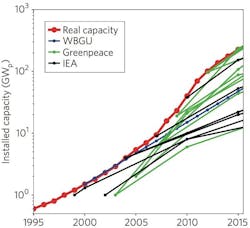Solar energy advances and deployments underestimated by at least a factor of 3
According to at least two recent articles, the technical advances in solar energy and the forecast deployments have been severely underestimated by as much as a factor of three.
According to a new study by the Mercator Research Institute on Global Commons and Climate Change (MCC; Berlin, Germany), the growth of solar energy has been grossly underestimated in the results of the models of the Intergovernmental Panel on Climate Change (IPCC). The MCC report adds that costs have dropped and infrastructures expanded much faster than even the most optimistic models had assumed, showing that in 2050, the percentage of photovoltaics in the global power supply could be three times higher than previously projected.
RELATED ARTICLE: Multi-junction solar cell exceeds theoretical limits at 30.2% efficiency
The study was published in the journal Nature Energy and says that the share of solar energy will likely range between 30 and 50%, instead of 5 to 17%, as suggested before--even if the global demand for electricity continues to rise.
The researchers, who include scientists from the Fraunhofer Institute for Solar Energy Systems (ISE), the Potsdam Institute for Climate Impact Research (PIK) and the University of Wisconsin, once again used the PIK computer model REMIND for their study. This time, however, they took into account the costs for grid expansion, storage and other integration options in greater depth and fed the model with new data, for example on the existing extent of photovoltaic infrastructure and the technological learning curve. Currently, the price of solar panels decreases by more than 20% when the produced quantity has doubled.
The geographical conditions in the US are especially favorable for photovoltaic technology. Because of widely-used air conditioning, there is a high demand for power in the afternoon during summer, which matches the supply of solar power particularly well.
"Solar power not only has huge potential in terms of resources, but is also environmentally friendly and the most cost-efficient technology for generating power in many parts of the world. Our study demonstrates that photovoltaics can be developed from a niche technology to the basis of a climate-friendly, affordable power supply," explains co-author Robert Pietzcker from the Potsdam Institute for Climate Impact Research (PIK). "However, whilst the important players in the sector, such as the International Energy Agency, continue to massively underestimate the extent to which solar power can contribute to climate protection, the risk of unprofitable investments and missed business opportunities remains. In order to make a stable power system with 20 to 30 percent photovoltaic energy possible within the next 15 years, we need to get on the right track now."
"Promising ideas are being fostered within laboratories and development departments of numerous companies, meaning it will be possible to reduce costs even further on a long-term basis," says Jan Christoph Goldschmidt, leader of the "Novel concepts for solar cells" team at Fraunhofer ISE. "Our study indicates that, under realistic assumptions, photovoltaics will become the most important power source in the world--at least if we take climate protection seriously and focus on the most affordable kind of technology."
In another article from Vox Media, it reveals that solar and wind energy have been underestimated by analysts and politicians again and again and again. They have gotten cheaper and scaled up faster than even the most optimistic forecasts of a decade ago, or even a few years ago.
SOURCES: MCC; https://www.mcc-berlin.net/en/media/press-information/press-release-detail/article/importance-of-solar-energy-underestimated-by-a-factor-of-three.html and Vox Media; https://www.vox.com/energy-and-environment/2017/8/30/16224582/wind-solar-exceed-expectations-again

Gail Overton | Senior Editor (2004-2020)
Gail has more than 30 years of engineering, marketing, product management, and editorial experience in the photonics and optical communications industry. Before joining the staff at Laser Focus World in 2004, she held many product management and product marketing roles in the fiber-optics industry, most notably at Hughes (El Segundo, CA), GTE Labs (Waltham, MA), Corning (Corning, NY), Photon Kinetics (Beaverton, OR), and Newport Corporation (Irvine, CA). During her marketing career, Gail published articles in WDM Solutions and Sensors magazine and traveled internationally to conduct product and sales training. Gail received her BS degree in physics, with an emphasis in optics, from San Diego State University in San Diego, CA in May 1986.
